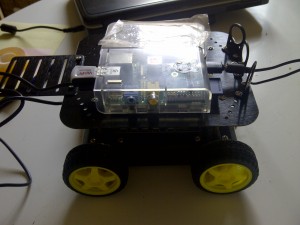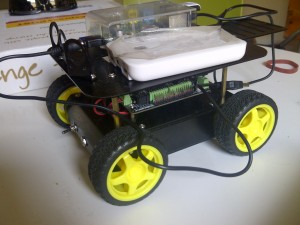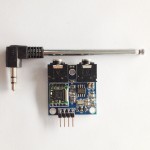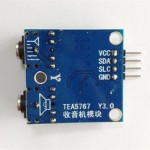We want to send commands to our remote-control Arduino car. One way to communicate directly with Arduino from Python is through Serial interface. For this we need a Python library called pySerial, which allows direct signal manipulation via serial ports.
Installation
PySerial is available as a standard Debian package.
sudo apt-get install python-serial
Sending messages
Open python in command line
python
>>> import serial
>>> ser = serial.Serial(0) # open first serial port
>>> print ser.portstr # check which port was really used
>>> ser.write("hello") # write a string
>>> ser.close() # close port
Receiving messages
>>> ser = serial.Serial('/dev/ttyACM0', 19200, timeout=1)
>>> x = ser.read() # read one byte
>>> s = ser.read(10) # read up to ten bytes (timeout)
>>> while 1:
... line = ser.readline() # read a '\n' terminated line
... print line
>>> ser.close()
Arduino side
Make sure your Arduino board is pre-uploaded with codes to listen and print what it received on the Serial status panel.
int incomingByte = 0; // for incoming serial data
void setup() {
Serial.begin(9600); // opens serial port, sets data rate to 9600 bps
}
void loop() {
// send data only when you receive data:
if (Serial.available() > 0) {
// read the incoming byte:
incomingByte = Serial.read();
// say what you got:
Serial.print("I received: ");
Serial.println(incomingByte, DEC);
}
}
Once you understand the basic concept of sending commands via Serial port, please follow the instruction on how to put them all together:
Raspberry Internet Rover Part 1 – Robotics Basics
Or
Download the complete Arduino Sketch, and work out ways to talk to it.
[post_view]
8 thoughts on “Controlling Arduino Motors via Raspberry-Hosted Website (Part 2)”
Comments are closed.



The websocket server gives me “segmentation fault”. It runs fine on Ubuntu, but crash when started on Raspbian.
I think the best alternative is to create a UDP Packet listener in Python, and then send messages via socket.io in NodeJS program. Call the NodeJS functions from within a HTML file, and transmit the messages to Python which then relay it to Arduino board via PySerial.
It sounds too overwhealmhing, here is the summary:
web client (html)
|
V
Raspberry Pi (nodeJS server->Python UDP server->Serial Class)
|
V
Arduino Board like Romeo (arduino)
NodeJS with CoffeeScript servers are lightweight and can be hosted via Lighttpd on Raspbian without abusing the limited ARM processor too much.
didn’t work for me 🙁
which part doesn’t work? Any error?
ser =serial.serial(0) and i get module object has no attribute serial
>>> import serial
>>> ser = serial.Serial(0)
doesn’t recongnise serial..i don;t know why…
another question…does it work with an arduino uno and a ardumoto shield?
Nice post! We built a similar project. However, we installed an Android device onto a RC car and used an IOIO board instead to control it autonomously. Here is the preliminary result:
http://youtu.be/vkvkfcqEUkk
After you have pyserial module installed, open the right USB / serial port like ser=serial.Serial(“/dev/ttyACM0”). It is case senstive too, make sure you have S with caps on.
If you want pure Python, another method would be to use Tornado websocket server as discussed in this post: https://www.linuxcircle.com/2015/04/13/raspberry-pi-pololu-maestro-python3-tornado-servo-control-part-2/